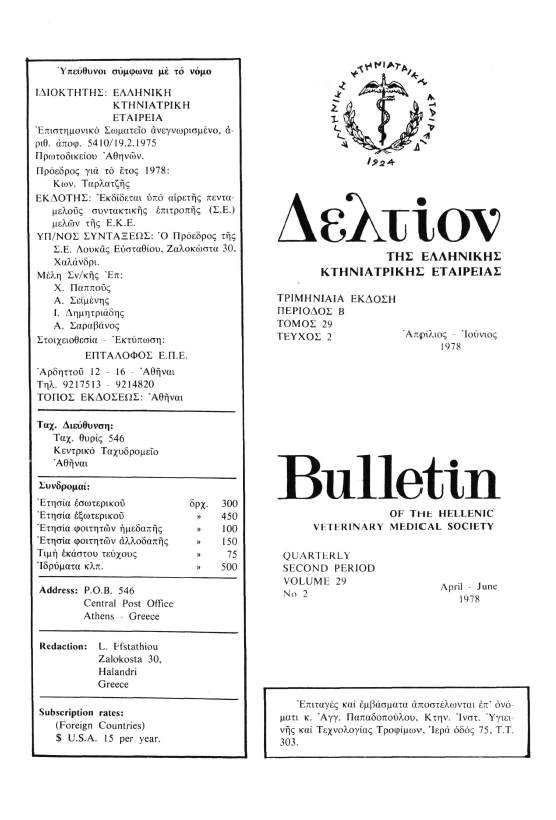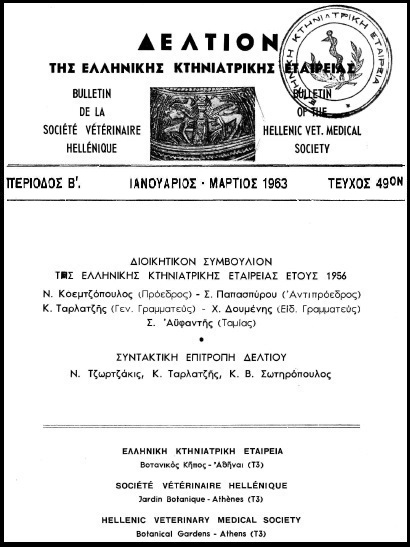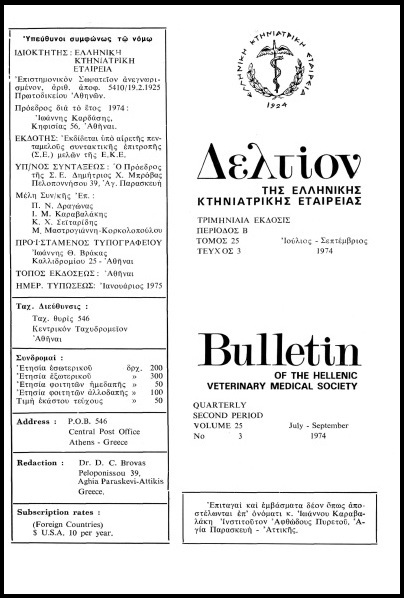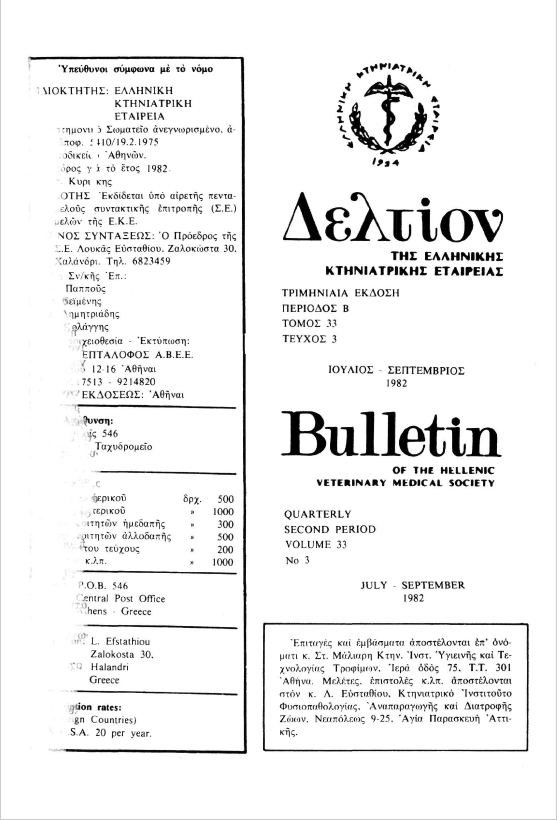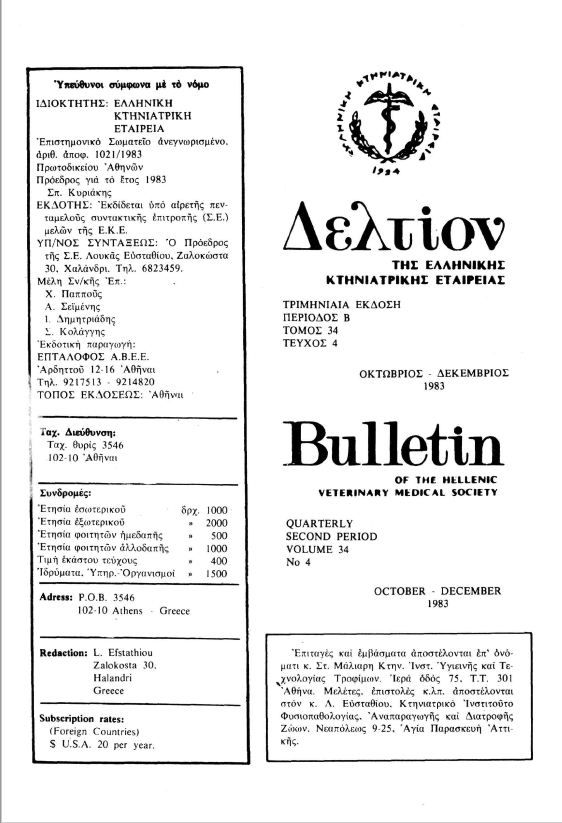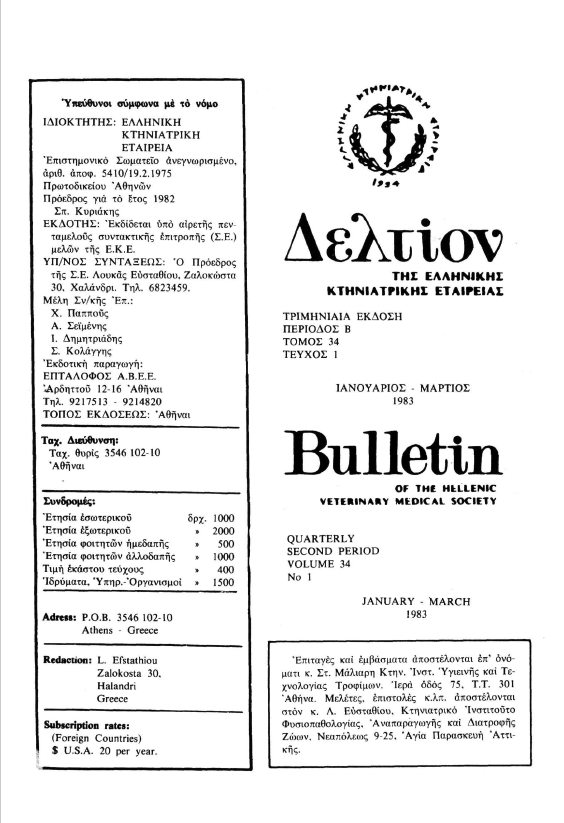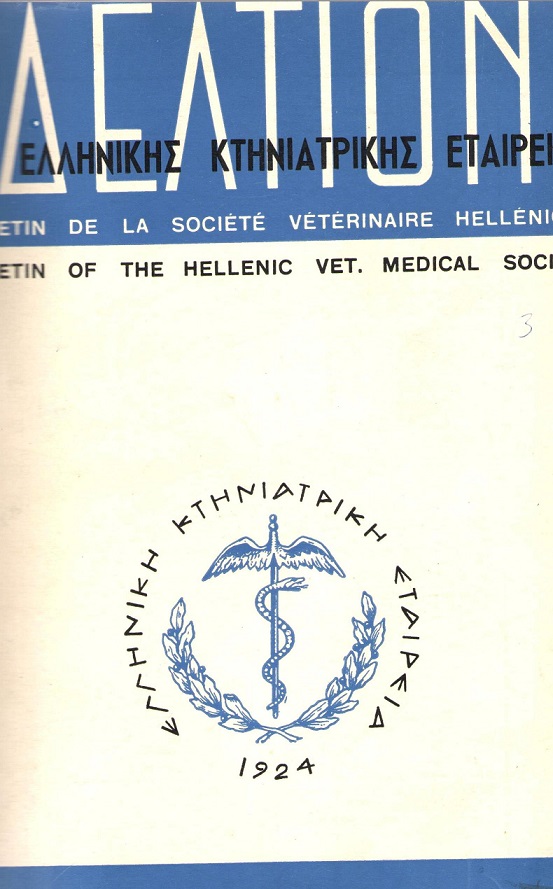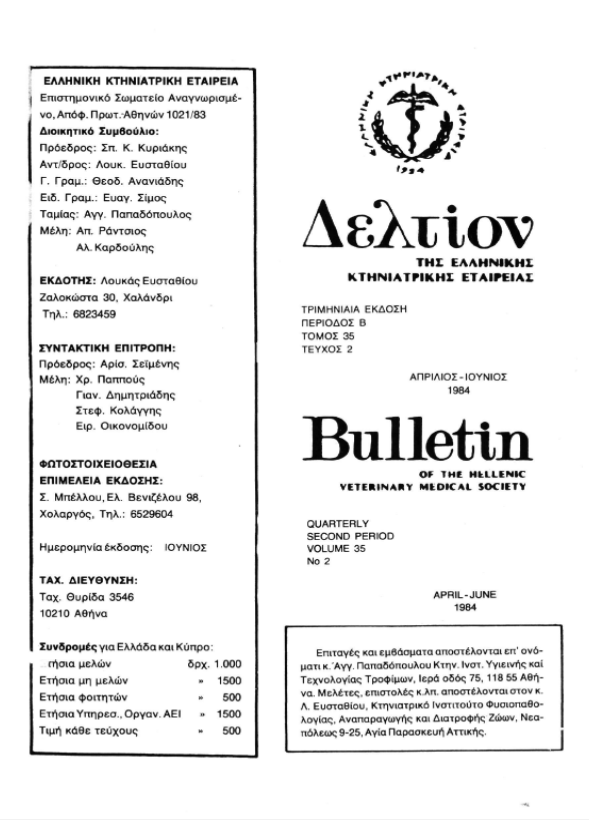Μελέτη έπί τής δραστικότητος τής δια του ποσίμου ύδατος χορηγούμενης άπραμυκίνης εις άπογαλακτισθέντα χοιρίδια πάσχοντα εκ κολοβακτηριδιάσεως
Аннотация
Κατά τήν παρούσαν έργασίαν έμελετήθη ή δραστικότης τής άπραμυκίνης, ενός νέου γλυκοσιδικοΰ αντιβιοτικού, διά τήν πρόληψιν καί θεραπείαν της κολοβακτηριδιάσεως καί τής νόσου τοΰ οιδήματος τών άπογαλακτισθέντων χοιριδίων. Ή άπραμυκίνη ύπό τήν ύδατοδιαλυτήν της μορφήν έχορηγήθη είς δύο δόσεις, 200 καί 300 mg άνά λίτρον ποσίμου ύδατος καί μέ διάρκειαν θεραπευτικής αγωγής 3ημερον διά χοιρίδια άπογαλακτισθέντα τήν 21ην ήμέραν καί 7ημερον διά τοιαύτα άπογαλακτισθέντα τήν 35ην ήμέραν. Είς τήν τελευταίαν περίπτωσιν έγένετο σύγκρισις τής αποτελεσματι ότητος της έναντι της ύδατοδιαλυτής άμπικιλλίνης χορηγηθείσης είς δόσιν 200 mg/λίτρον ποσίμου ύδατος επίσης έπί 7ημερον. Τό σύνολον τών χοιριδίων τών πειραματισμών τής ημετέρας έρεύνης άνήλθεν είς 801. Κατά τήν κολοβακτηριδίασιν τών άπογαλακτισθέντων τήν 21ην ήμέραν χοιριδίων ή άπραμυκίνη, είς άμφοτέρας τάς δοσολογίας, προεκάλεσε (1) σημαντικήν (Ρ < 0.001) μείωσιν τής θνητότητος: 24.14% διά τους μάρτυρας έν συγκρίσει προς 1.16% καί 1.12% διά τάς δόσεις τών 200 καί 300 mg/λίτρον ποσίμου ύδατος αντιστοίχως (2) εμφανή περιορισμόν τής διάρροιας καί της διαρκείας τών νοσηρών συμπτωμάτων καί (3) σημαντικήν (Ρ < 0.001) βελτίωσιν τής μέσης ημερησίας αυξήσεως τοΰ σωματικού βάρους τών χοιριδίων κατά 133.6% καί 109.6% έν συγκρίσει προς τους μάρτυρας, διά τάς δόσεις των 200 καί 300 mg άπραμυκίνης άνά λίτρον ποσίμου ύδατος. Είς την περίπτωσιν της νόσου του οιδήματος, (απογαλακτισμός είς 21 ημέρας), ή άπραμυκίνη συνετέλεσε είς τήν άναχαίτησιν της νόσου δια (1) της ύποχωρήσεως της νοσηρότητος και (2) περιωρισμοΰ της θνητότητος ή οποία είς μέν τους μάρτυρας άνήλθεν είς ποσοστόν 22.73% είς δέ τάς ύπό θεραπείαν ομάδας περιωρίσθη είς 2.59% δια τήν δόσιν των 200 mg/1 οδατος και 3.51% διά τήν δόσιν των 300 mg/1. Ό περιορισμός της θνητότητος απεδείχθη στατιστικώς σημαντικός (Ρ < 0.001) δΓ άμφοτέρας τάς δοσολογίας της άπραμυκίνης έν συγκρίσει προς τους μάρτυρας. Κατά τήν κολοβακτηριδίασιν των άπογαλακτισθέντων τήν 35ην ήμέραν χοιριδίων ή άπραμυκίνη είς άμφοτέρας τάς δοσολογίας συνετέλεσεν είς ταχυτέραν ύποχώρησιν της διάρροιας και νοσηρότητος έν συγκρίσει προς τήν άμπικιλλίνην. Ή δόσις των 200 mg άπραμυκίνης άνά λίτρον ύδατος ητο πλέον αποτελεσματική και της άμπικιλλίνης, καί της δόσεως των 300 mg/1 ύδατος άπραμυκίνης είς τήν βελτίωσιν της μέσης ημερησίας αυξήσεως του σωματικού βάρους των χοιριδίων (αυξησις κατά 5.4%) καί του συντελεστού εκμεταλλεύσεως τροφής (βελτίωσις κατά 6.49%). Είς δτι άφορα τήν θνητότητα, αύτη έκυμάνθη είς τά ακόλουθα επίπεδα: 6.17% κατά τήν θεραπείαν με άμπικιλλίνην, 5.2% κατά τήν χορήγησιν άπραμυκίνης 200 mg/1 καί 1.12% κατά τήν χορήγησιν 300 mg/1 ποσίμου ύδατος άπραμυκίνης. Τέλος απεδείχθη ή ύπαρξις των κάτωθι όροτύπων της E. coli έκ χοιριδίων πασχόντων έκ κολοβακτηριδιάσεως (άπογαλακτισθέντων τήν 35ην ήμέραν): 0149: Κ91, Κ88 a,c καί 08: Κ87, Κ88 a,c.
Article Details
- Как цитировать
-
ΣΤΟΦΟΡΟΣ Ε., ΚΥΡΙΑΚΗΣ Σ., ΑΝΔΡΕΩΤΗΣ Ι., ΤΣΑΛΤΑΣ Κ., ΣΙΜΟΣ Ε., & ΣΤΟΫΤΣΙΟΥ Κ. (2019). Μελέτη έπί τής δραστικότητος τής δια του ποσίμου ύδατος χορηγούμενης άπραμυκίνης εις άπογαλακτισθέντα χοιρίδια πάσχοντα εκ κολοβακτηριδιάσεως. Journal of the Hellenic Veterinary Medical Society, 29(2), 105–119. https://doi.org/10.12681/jhvms.21345
- Выпуск
- Том 29 № 2 (1978)
- Раздел
- Articles

Это произведение доступно по лицензии Creative Commons «Attribution-NonCommercial» («Атрибуция — Некоммерческое использование») 4.0 Всемирная.
Authors who publish with this journal agree to the following terms:
· Authors retain copyright and grant the journal right of first publication with the work simultaneously licensed under a Creative Commons Attribution Non-Commercial License that allows others to share the work with an acknowledgement of the work's authorship and initial publication in this journal.
· Authors are able to enter into separate, additional contractual arrangements for the non-exclusive distribution of the journal's published version of the work (e.g. post it to an institutional repository or publish it in a book), with an acknowledgement of its initial publication in this journal.
· Authors are permitted and encouraged to post their work online (preferably in institutional repositories or on their website) prior to and during the submission process, as it can lead to productive exchanges, as well as earlier and greater citation of published work.

